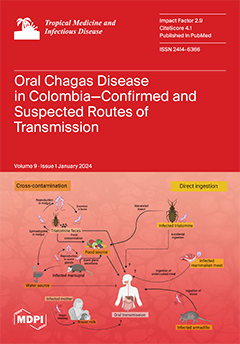COVID-19 significantly disrupted tuberculosis (TB) services in Vietnam. In response, the National TB Program (NTP) integrated TB screening using mobile chest X-rays into COVID-19 vaccination events. This prospective cohort study evaluated the integrated model’s yield, treatment outcomes, and costs. We further fitted regressions
[...] Read more.
COVID-19 significantly disrupted tuberculosis (TB) services in Vietnam. In response, the National TB Program (NTP) integrated TB screening using mobile chest X-rays into COVID-19 vaccination events. This prospective cohort study evaluated the integrated model’s yield, treatment outcomes, and costs. We further fitted regressions to identify risk factors and conduct interrupted time-series analyses in the study area, Vietnam’s eight economic regions, and at the national level. At 115 events, we conducted 48,758 X-ray screens and detected 174 individuals with TB. We linked 89.7% to care, while 92.9% successfully completed treatment. The mean costs per person diagnosed with TB was $547. TB risk factors included male sex (aOR = 6.44,
p < 0.001), age of 45–59 years (aOR = 1.81,
p = 0.006) and ≥60 years (aOR = 1.99,
p = 0.002), a history of TB (aOR = 7.96,
p < 0.001), prior exposure to TB (aOR = 3.90,
p = 0.001), and symptomatic presentation (aOR = 2.75,
p < 0.001). There was a significant decline in TB notifications during the Delta wave and significant increases immediately after lockdowns were lifted (IRR(γ
1) = 5.00; 95%CI: (2.86, 8.73);
p < 0.001) with a continuous upward trend thereafter (IRR(γ
2) = 1.39; 95%CI: (1.22, 1.38);
p < 0.001). Similar patterns were observed at the national level and in all regions but the northeast region. The NTP’s swift actions and policy decisions ensured continuity of care and led to the rapid recovery of TB notifications, which may serve as blueprint for future pandemics.
Full article






